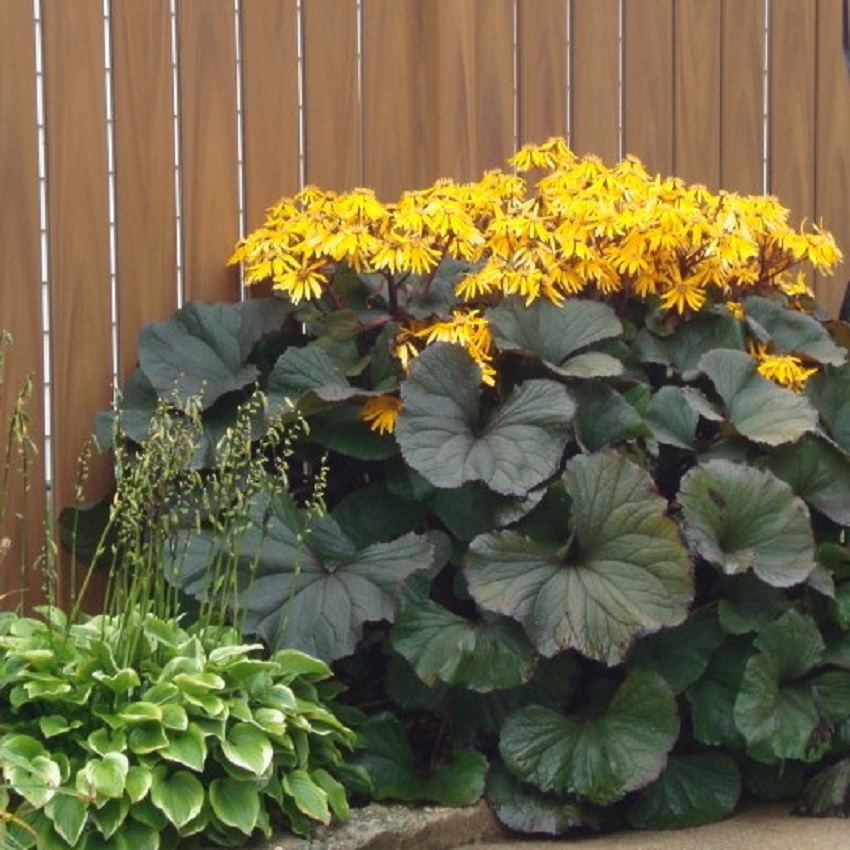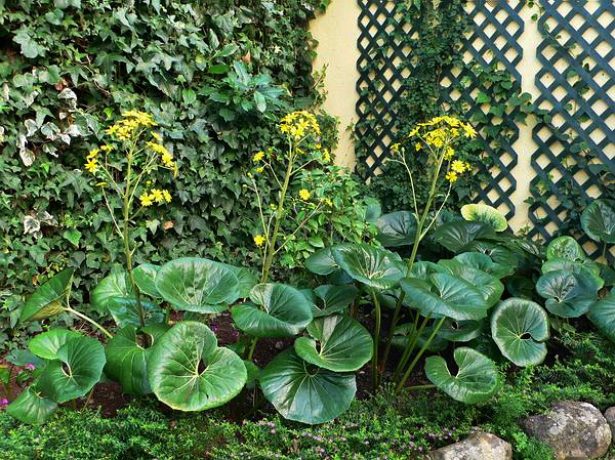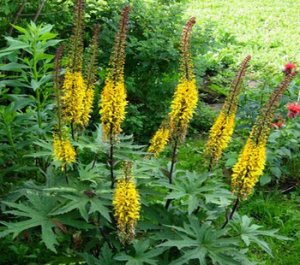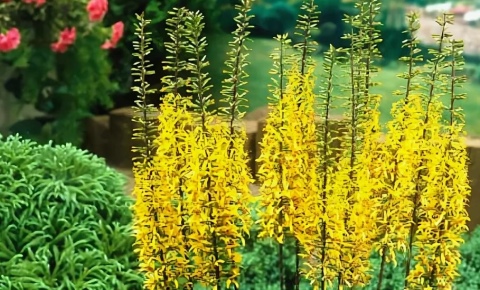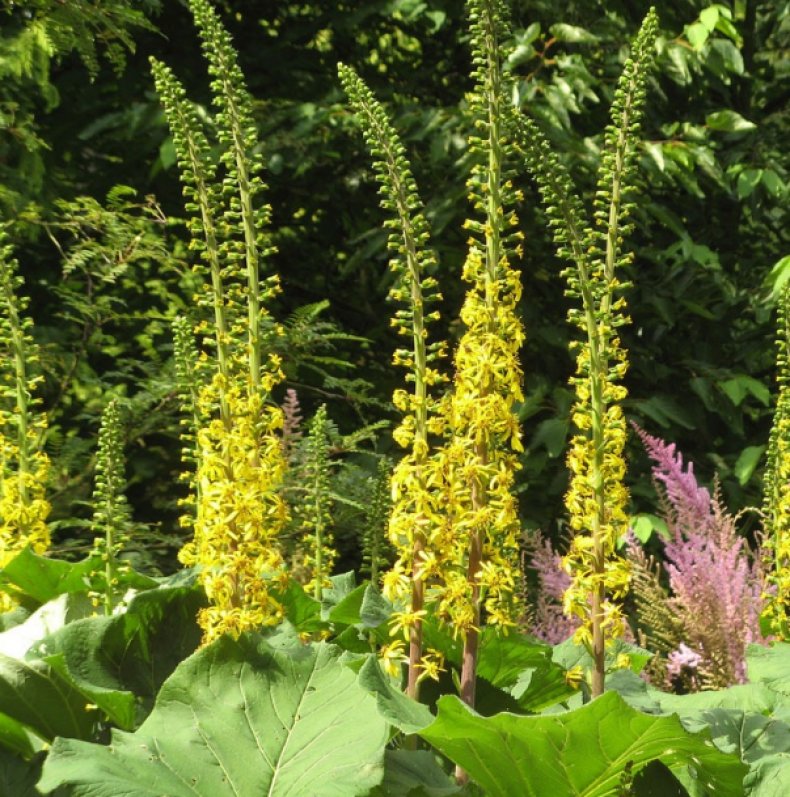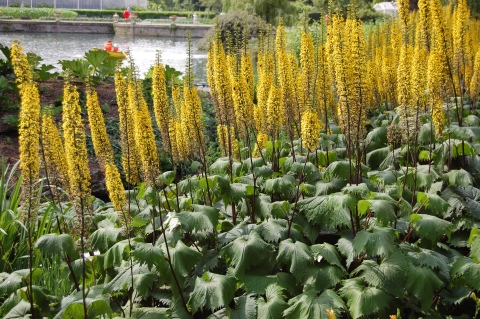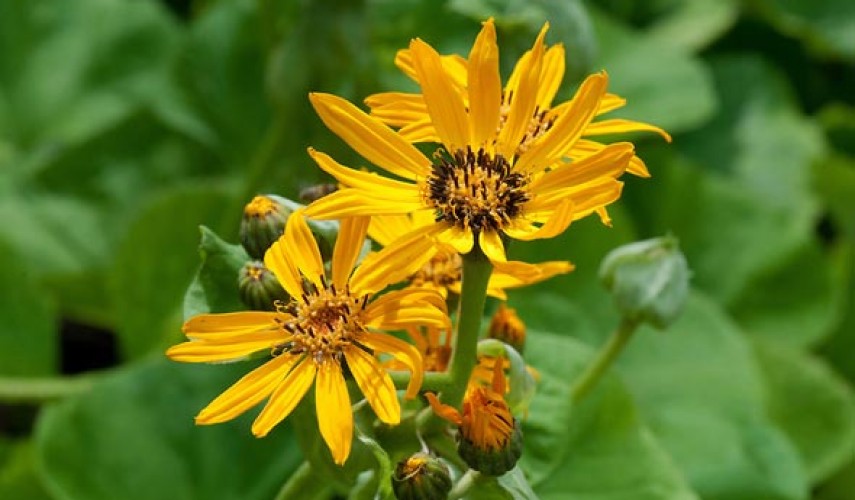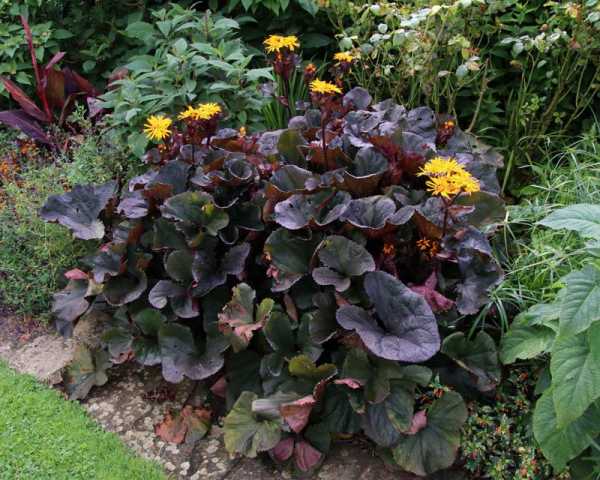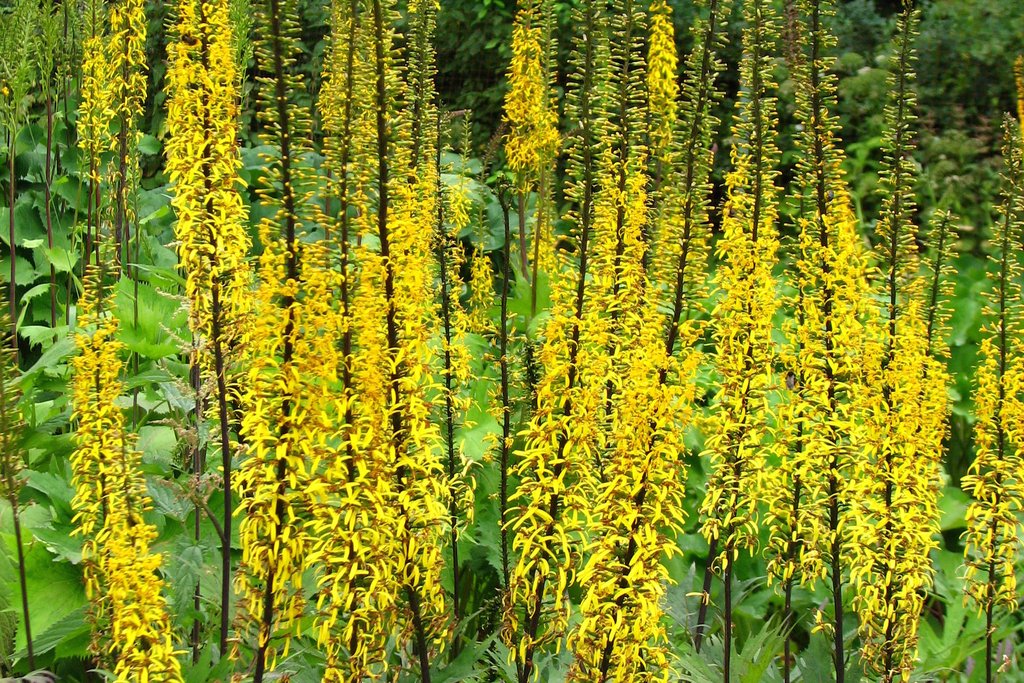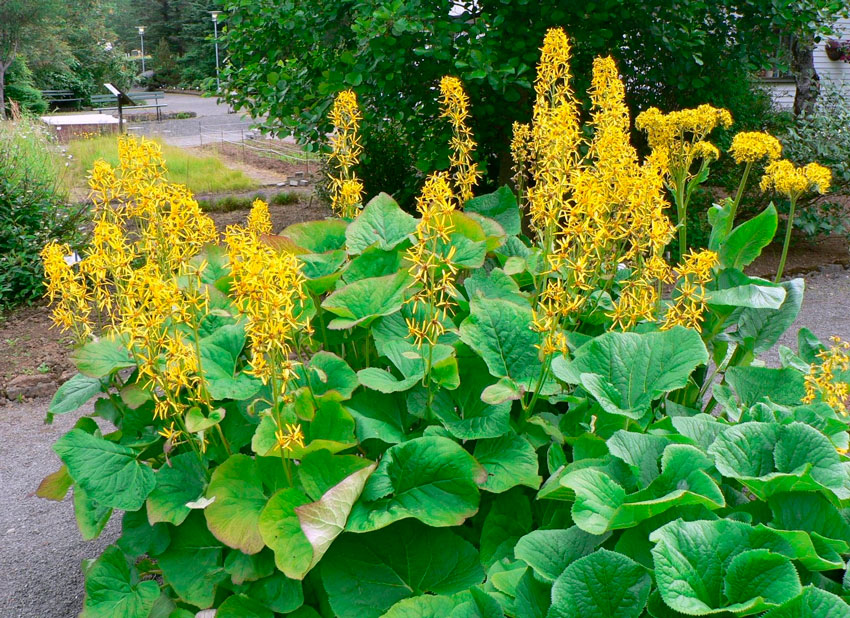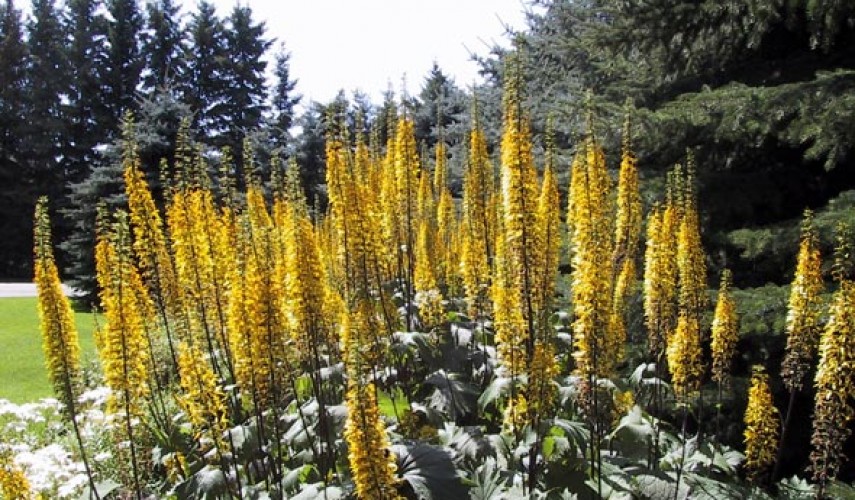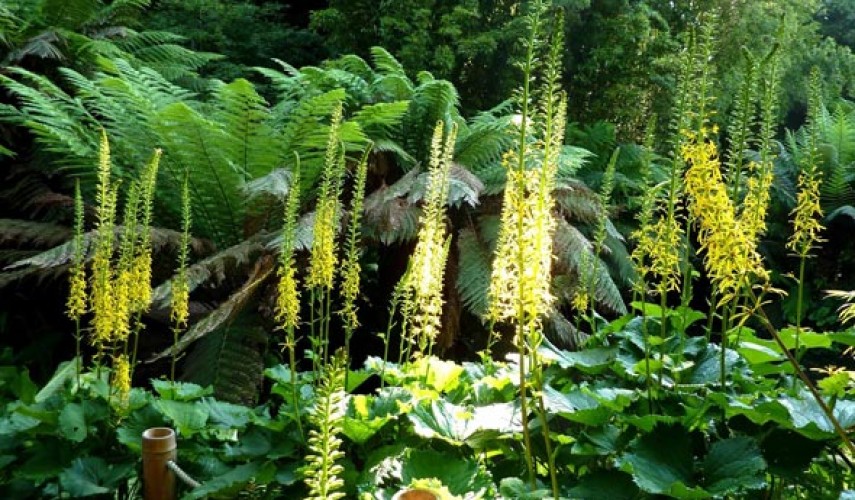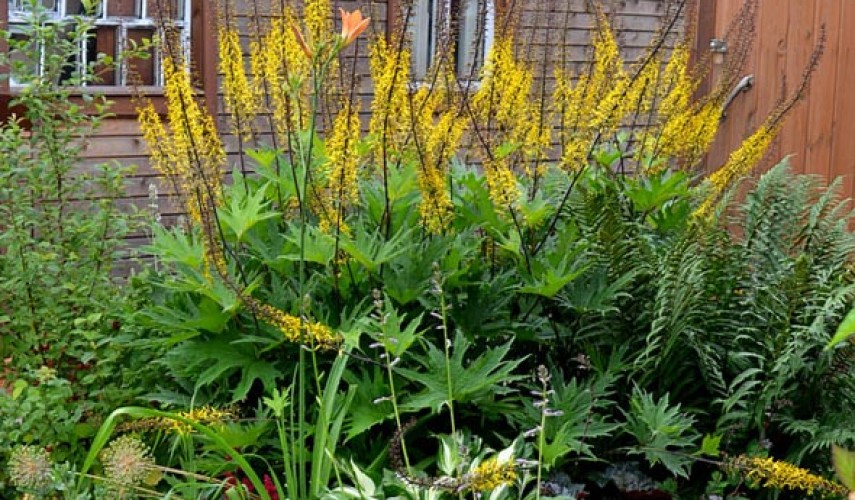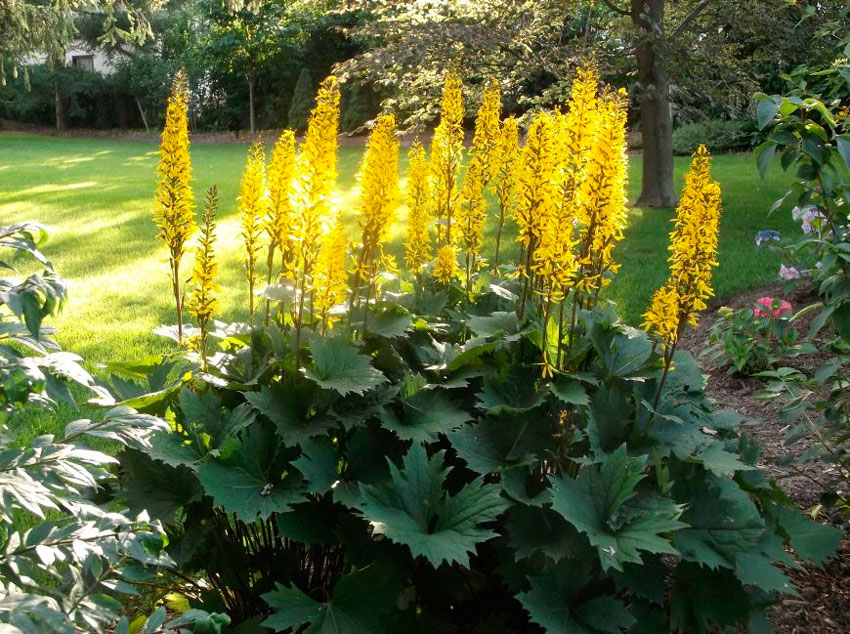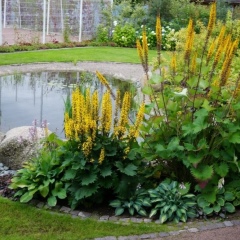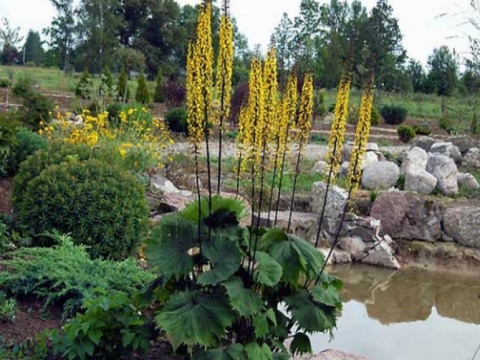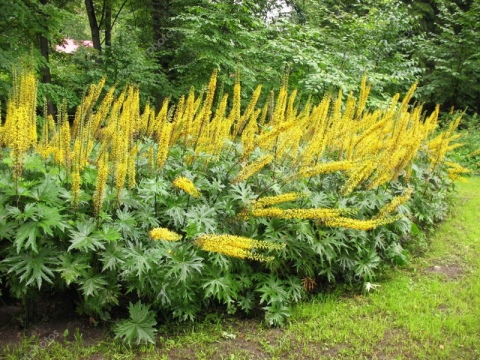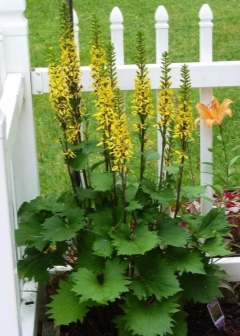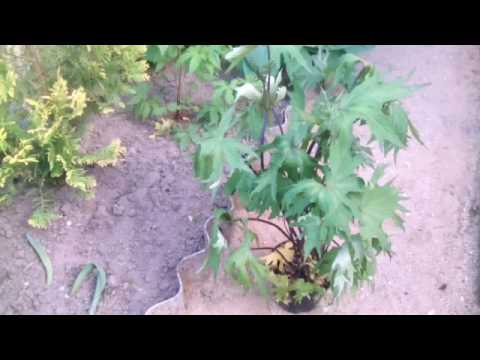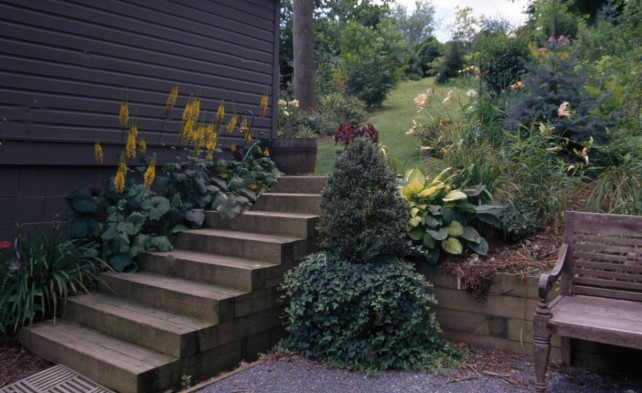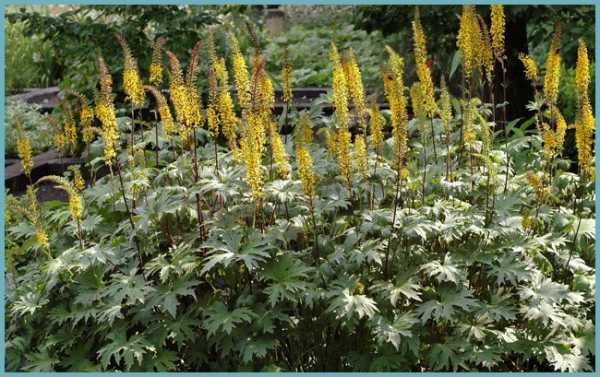Use in landscape design
Landscape designers agree that the scalloped buzulnik "Othello" looks very advantageous in group plantings. In addition to its attractive appearance, this placement allows you to hide aging tree crowns. The color-changing foliage will create new images, and the inflorescences will delight you with a riot and brightness of colors.

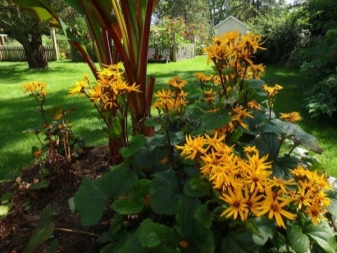
The plant looks and feels best in shaded areas or along the banks of water bodies. A combination with near-water plants, for example, marsh irises, will be effective. You can plant flowers alone.
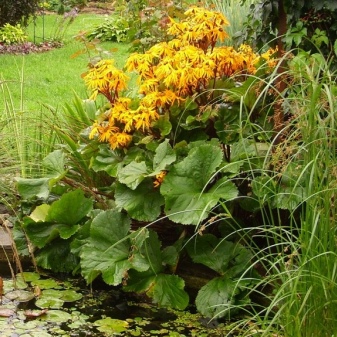
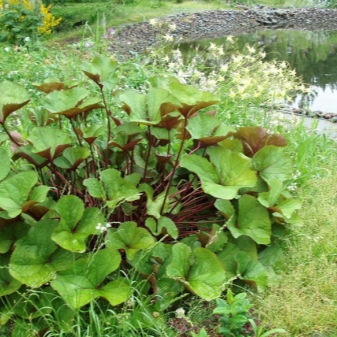
Planting in the same group of different varieties of buzulnik is not prohibited. They will look very interesting as they have different colors, heights and shapes.

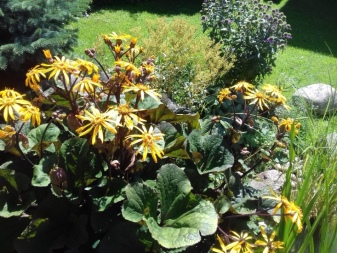
You can learn how to plant Othello toothed buzulnik by watching the video below.
Reproduction methods
Buzulnik toothed well tolerates vegetative reproduction. It is often not recommended to replant it, but you can change the place of growth every 10 years by dividing the rhizome when digging in the spring. This will allow the plant to rejuvenate, to enhance the brightness of the leaves, and increase their size. You can also use the layering method by digging strong shoots into the ground in the spring.

With seed reproduction, planting is best done in the fall, just before the very frosts. This will harden the seeds and eliminate stratification. Plants will bloom only for 3-4 years of cultivation. If you plan to self-distill seedlings, you will have to place the planting material in a damp cloth in February or early March, put it in a container and send it to the vegetable box of the refrigerator for 30 days. After stratification, the seeds can be immediately planted in the ground.


Pests and diseases
Buzulnik is rarely exposed to diseases and pests.
The most common disease of this flower is powdery mildew. The development of such a pathology is facilitated by increased humidity and heat. The disease can be recognized by the following signs:
- Mealy spots appear on the leaves. At the initial stage, they are easily washed off.
- Over time, the lower part of the leaf plates is damaged, which are covered with brown spots.
- The leaves begin to dry out and crumble, the plant gradually dies.
You need to deal with the problem with special fungicidal agents. For this purpose, Topaz and Hom preparations are suitable.
Additional Information. For the prevention of fungal diseases, it is recommended to spray with sulfur, milk whey. Irrigation is carried out up to three times per season.
During the period of budding and flowering, nitrogenous fertilizers cannot be used for feeding. It is better to give preference to substances with potassium and phosphorus. They have a beneficial effect on the whole plant and increase its resistance to various diseases.
Pests attack Buzulnik quite rarely, but the plant can suffer from slugs. They eat leaves and stems. The fight against these pests is not easy, and you need to start it in advance. The procedure includes several steps:
- During digging of the site, weeds are removed.
- Small trenches are prepared, at the bottom of which pepper, tobacco dust, sand, ground eggshells are poured - substances that will prevent the parasite from getting close to the flowers. You can place water bottles in the grooves to create a natural barrier.
- It is permissible to sprinkle gravel between rows and bushes.
- To get rid of pests, birds are attracted to the site, which feed on them.
- Fertilizers help well - superphosphate and potassium salt.If they are periodically scattered next to the plantings, then there will be practically no slugs. Substances are detrimental to them. The entire amount of the drug is divided into two parts and scattered at intervals of 40 minutes.
You can deal with slugs by collecting them by hand. However, not every gardener is ready for this. If desired, you can use chemical agents, for example, Groza, Meta.
In addition to slugs, snails can damage flowers. They fight them in similar ways and means.
Top dressing and transplanting
Buzulnik is very fond of feeding and fertilizing. You can use both organic and mineral substances.
If humus was added to the hole when planting, then nothing else is needed for the first year of development of the culture. In the future, it will need to be fed every year before flowering. For this purpose, mullein is used. On a bucket of 10 liters, take 1 liter of the substance, mix everything well and bring it under each bush. One plant will need 3 liters of solution, which is watered once every couple of weeks.
Additional Information. Top dressing is carried out every year. If the weather conditions change dramatically, fertilization is not carried out.
Mineral fertilizers are applied only to abundantly moistened soil, after the culture is well watered. In autumn, experienced gardeners recommend pouring mulch into the root zone; it is better to use humus for this purpose. In the spring they dig everything up, as a result, the soil and the plant receive nutrients. You can use wood ash to feed the flower.
Reproduction of Przewalski's buzulnik
To get a beautifully blooming and healthy Przewalski buzulnik in your flower bed, you can use one of two methods of plant propagation:
Vegetative method by dividing the bush, which goes well with a transplant or simply a rejuvenating treatment for the plant.
The seed method is more laborious, but also does not cause much trouble for gardeners.
It is only important to remember that the period from planting seeds to the first flowering will take about 3-4 years.
Buzulnik Przewalski - dividing the bush
It is easier to propagate the perennial buzulnik Przewalski by dividing the bush. The process itself is not difficult for the gardener:
- At the beginning of spring or late summer, a healthy shrub is selected with an age of at least 5-6 years.
- It is not necessary to dig the flower completely out of the ground. With a sharp shovel, you just need to separate about a third of the root with the stem.
- The roots of the planting material are washed with water and are further divided by the number of buds. All cuts are processed with crushed charcoal.
- The plots are planted in pre-prepared holes with fertile soil, sprinkled with earth, watered and mulched.
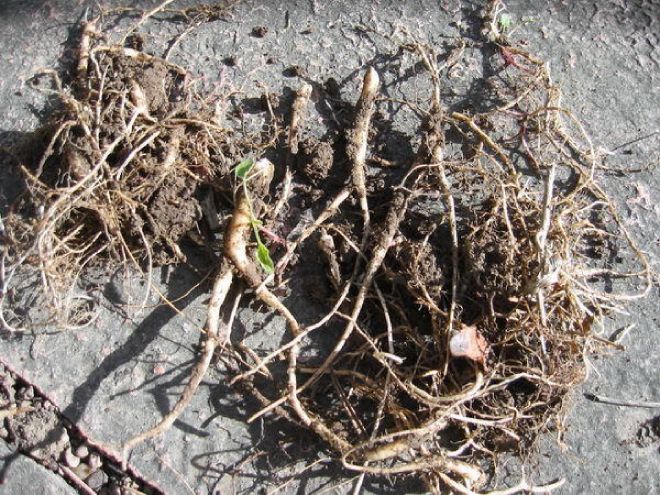
Buzulnik Przewalski from seeds
Some flower growers successfully grow Przewalski's buzulnik from seeds at home. To do this, they:
- After the end of flowering, the seeds are expected to ripen, which lasts about 3-4 weeks. Collect planting material.
- Prepare wells with a depth of about 10 cm at a distance of 0.5 m from each other.
- Each hole is watered and several seeds are spread into it.
- Sprinkle the seedlings with slightly compacted soil.
- For the winter, it is better for plantings to build small greenhouses from film with the possibility of airing.
- Next spring, young seedlings can be transplanted to a permanent place, if necessary.
How to care for a Przewalski buzulnik
Buzulnik Przewalski is an unpretentious plant that even a beginner can handle. However, some care features are still required to be observed.
Watering
The plant loves moist and nutritious soil. It will grow well next to water bodies and in the shade of large trees. In this case, irrigation will only be needed in very dry times. If the flower grows on drier soil, then watering should be carried out regularly. To maintain the necessary moisture, it is allowed to use mulch in the form of shavings or straw.
Continuous irrigation is carried out until the onset of autumn days, after which the frequency is halved to avoid decay of the root system. In addition, this type of buzulnik also does not like to be in constant moisture, therefore it is not recommended to be too zealous.
On dry days, spraying the plant with warm water is allowed. The procedure is carried out in the morning or in the evening in order to prevent direct sunlight from reaching the foliage and to avoid burns.
Attention! The Przewalski variety does not like to be in the sun, so open areas will not work for him - the plant will wither and may die
Top dressing
Buzulnik Przewalski, like any other cultivated plant, perfectly accepts various dressings. They can be organic and mineral. The first time fertilization is applied during planting, it is recommended to use mineral fertilizers that are most suitable for this type of soil. Humus is added every year.
In the spring (in May), the culture is fertilized with a solution of cow dung. Mix with water in a ratio of 1/10. One bush will require up to 4 liters of ready-made solution, watered at the root.
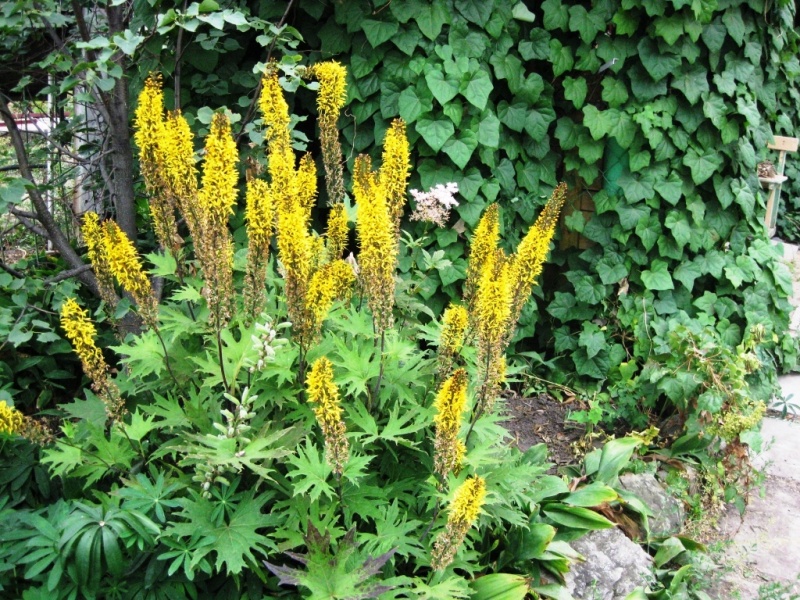
Buzulnik Przewalski will add decorative effect to any area
Pruning
Buzulnik Przewalski does not require pruning. Remove old and dried leaf blades, branches. If reproduction is not planned using self-seeding, then immediately after flowering, it is required to cut off the inflorescences. In this case, the appearance of seeds will not occur. In addition, nutrients begin to be distributed to the leaves and shoots, and not only go to the inflorescences.
Pruning is also carried out before preparing for the winter period. The branches are cut very low, then they sprinkle the bush with leaves, mulch with humus. If you wish, you can cover the plant with a special material, although the culture survives the winter frosts quite normally.
For reference! Planting and caring for Przewalski's buzulnik does not require much effort and time. Even an inexperienced person can handle this kind of culture.
Diseases of Buzulnik Przewalski
Many landscape designers valued Przewalski's yellow buzulnik for strong immunity, thanks to which the flower is practically not affected by diseases and pests. However, due to high humidity on the site, there may be:
- Powdery mildew affection. This is a fungal disease that develops on leaves and shoots. Recognizable for its white bloom followed by the release of droplets of liquid. It develops in early summer and can lead to the complete destruction of plantations. At the first symptoms, the plant should be urgently sprayed with a fungicidal preparation, for example, "Aktellik" or "Aktara", in order to prevent the death of the entire planting.
- Of the pests on wet soil, slugs and snails are a threat, eating leaves and leading to a loss of decorativeness of the plant. To combat them, gardeners recommend scattering superphosphate granules, eggshells, small pebbles and other substances with uneven edges under the bushes, which will mechanically prevent pests from getting close to the plants.
How to take care of it properly?
Buzulnik toothed is not too picky about care. Its cultivation is carried out without intensive interference from the owners of the site.
It is only important to observe the exact watering regime and periodically fertilize the planting. Weeding is only important in the early spring months and early summer.
The overgrown leaves will then interfere with the growth of the weed. For the winter, the buzulnik is pruned, removing tall peduncles. The rosette of leaves is preserved, providing additional shelter for the roots in winter
It is worth paying attention to the fact that during winters with little snow, it is better to additionally mulch. In the spring, fallen leaves and mulch are carefully removed

Watering
Regular application of moisture is of great importance for this crop. It's all about the large area of leaves of the toothed buzulnik, which loses a lot of moisture on hot days.In addition, the surface root system is highly dependent on the level of dryness of the soil. In hot weather, ligularia requires two watering during the day. In the morning and evening hours, the leaves can be sprayed or moisture can be applied under the leaf outlet. Watering cannot be done during the day, as the shoots will receive sunburn.

Fertilizer
If the preparatory work has been carried out correctly, the soil will remain sufficiently fertile for a long time. Initially, it will be necessary to fertilize the soil rich in humus no earlier than 2-3 years after planting. In the future, timely feeding will help maintain the brightness of the leaves and abundant flowering. It should be carried out according to the following scheme:
- plants are watered abundantly;
- 2-3 times a season, infusion of cow manure is applied at a concentration of 1 to 10;
- to enhance the effect, wood ash or about 50 g of superphosphate is periodically added to the solution.

Landing rules
Best of all, the buzulnik feels in the shade. He does not like direct sunlight, this must be taken into account when planning seats for landing... In addition, you need to take into account the exactingness in relation to humidity. Gardeners recommend placing the plant along the walls or in the back of the flower beds. It will look good between trees too.
The composition of the soil needs a special buzulnik. An exceptionally well-moistened soil rich in nutrients is suitable for him. It is possible to plant a flower on heavy clay soil that has drainage problems. If the site is located in an area prone to temporary flooding, this will not be particularly difficult. For Othello to fully grow and develop, it does not require significant efforts, but a number of procedures will be necessary.
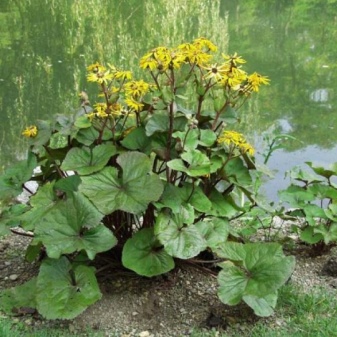
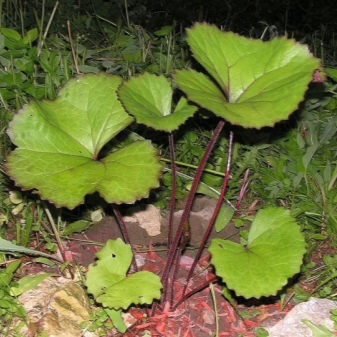
In addition to the location, factors such as the competent choice of planting material and the preparation of the beds are important for the toothed buzulnik. Gardeners recommend buying seeds or seedlings at specialized points. You can go to both the retail store and the nursery. If we are talking about a seedling, it is necessary to evaluate its appearance in order to exclude the possibility of damage and any diseases. The integrity of the root system should also be monitored - any violations in it can become critical for the bush.
Before planting a flower, you should prepare the beds. This is done just before landing. The soil is carefully dug to the depth of the shovel bayonet.
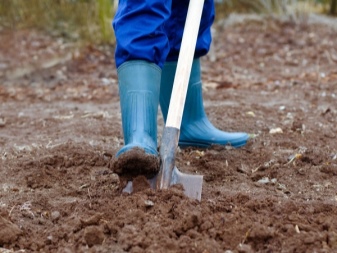
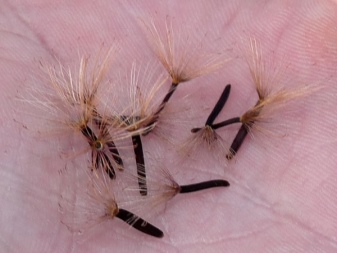
Planting is done in the spring, before the buzulnik dissolves the leaves. The size of the landing pits should be 40x40 centimeters, and the distance between them should be from one to one and a half meters. When placed in the hole, the root system of the seedlings is neatly straightened, and from above it is filled with soil mixture prepared in advance. In addition to garden soil, humus and wood ash, as well as superphosphate, are added to it.
The buds should be above the ground. After planting, the plant is thoroughly watered.

